A friend from my previous life in real estate, Bill Holt, sent me an email the other day that contained a series of old black & white photos. Apparently, these photos were discovered on the film from a Brownie camera found stored in an old footlocker belonging to a sailor who was serving on the USS Quapaw ATF-110 in 1941. When developed, the photos contained spectacular images of the attack on Pearl Harbor on December 7th of that year.
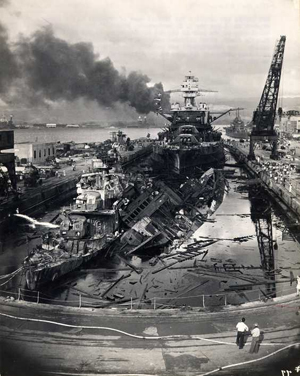
These were definitely some spectacular photos, so I sent them off to my Dad, since he served in WWII. Dad was a belly gunner in a B-17-E Bomber during the war. For those of you who don’t know what a belly gunner was, after the B-17 was airborne, these airmen climbed down through a hatch that accessed a small plastic sphere in the rear of the plane. They curled up in an upside-down position while the sphere was hand-cranked down until it rested beneath the plane. Then the ball was rotated so that the belly gunner was sitting in an upright position, from where he could operate hand and foot pedals that turned the ball in a circle and fired machine guns at enemy fighters. Once rotated into this upright position, the belly gunner was totally cut off from the interior of the aircraft.
The belly guns and the machine guns in the main fuselage were the only weapons the bombers had because their payload was devoted to carrying the bombs. Up to the point where the bombers entered “the slot” (the target area), they had the protection of fighter aircraft that flew along with the formation. But once they hit “the slot” the fighters broke away and the bombers were on their own. At this point, the pilot turned control over to the navigator, who flew the plane until the target was in sight and lined up. It was the navigator who gave the command to drop the bombs.
The B-17’s were at their most vulnerable during their time in “the slot” because they were flying at low altitudes and were virtually defenseless against the flak from the ground. Between gunfire from enemy fighters and the flak, the mechanisms of the belly ball were often damaged and the hand cranks used to lower and raise the ball failed, so the belly gunner was trapped inside. Whenever this occurred the belly gunner knew he was a goner because a belly ball in the lowered position would impact the runway upon landing.
For many years, my father refused to talk about the war. “It’s ancient history – it was 50 years ago,” he would say. But then one day we brought him some historic photos of the inside of a B-17 and asked if he recognized the plane. It took him just a second or two before he replied, “My God – that’s an old B-17.” He started talking and didn’t quit for over an hour. He described what it was like to be in the war – how they were all so young and thought they were invincible. “We used to fight over who would take someone’s place if they were unable to fly a mission.” He told us about the guys he flew with – how most of them are now long gone. He told us about coming back from a successful mission and being greeted with carrot sandwiches and all the shots of whiskey you could drink (the carrot sandwiches were for their eyesight – I’m sure I don’t have to explain the shots). And I wrote it all down because I knew I would use this material some day.
When Dad got these most recent photos, he emailed me back the very next day:
“Great pictures–Steve andTony both looked at them—very interesting to them because it was way before their time. I remember that day very well. Dad came out on the back porch and yelled across to the vacant lot where all of us teenagers were playing football and told us he heard on the news about Pearl Harbor. I remember one of the guys saying, ‘Where the hell is Pearl Harbor?’ The vacant lot is gone now–a house built on it–and so are some of the guys.”
I am gratified to know a little something about this history. My niece, who is now 22, told me when she was in elementary school that her history book contained only two pages about WWII. I find that appalling. War is not something to be taken lightly. It is not a game. We should not enter into it without grave consideration, accurate intelligence, and a direct threat to our nation. But when these elements are truly present, as they were in WWII, we must respectfully remember our history. To that end, the following are the statistics from the bombing of Pearl Harbor, as so succinctly stated in the email I received, and some more of the photos:

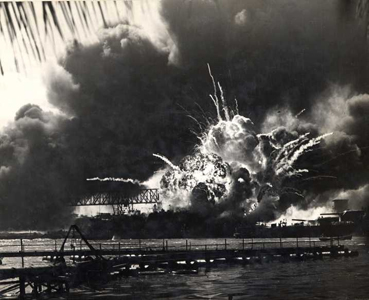
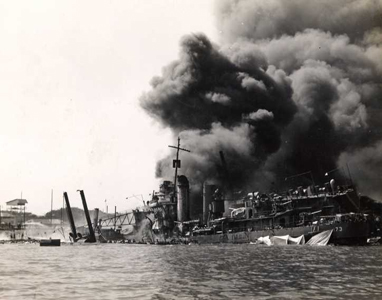

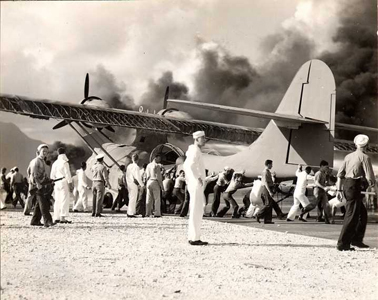
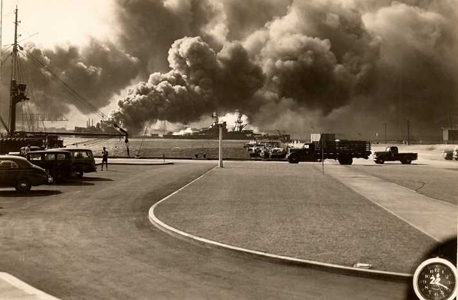

Casualties/Wounded:
US Army: 218 Killed In Action (KIA), 364 Wounded In Action (WIA)
US Navy: 2,008 KIA, 710 WIAUS Marine Corps: 109 KIA, 69 WIA
Civilians: 68 KIA, 35 WIA
TOTAL: 2,403 KIA, 1,178 WIA
Battleships
USS Arizona (BB-39) – total loss when a bomb hit her magazine
USS Oklahoma (BB-37) – Total loss when she capsized and sunk in the harbor
USS California (BB-44) – Sunk at her berth. Later raised and repaired
USS West Virginia (BB-48) – Sunk at her berth. Later raised and repaired
USS Nevada – (BB-36) Beached to prevent sinking. Later repaired
USS Pennsylvania (BB-38) – Light damage
USS Maryland (BB-46) – Light damage
USS Tennessee (BB-43) Light damage
USS Utah (AG-16) – (former battleship used as a target) – Sunk
Cruisers
USS New Orleans (CA-32) – Light Damage
USS San Francisco (CA38) – Light Damage
USS Detroit (CL-8) – Light Damage
USS Raleigh (CL-7) – Heavily damaged but repaired
USS Helena (CL-50) – Light Damage
USS Honolulu (CL-48) – Light Damage
Destroyers
USS Downes (DD-375) – Destroyed. Parts salvaged
USS Cassin – (DD-37 2) Destroyed. Parts salvaged
USS Shaw (DD-373) – Very heavy damage
USS Helm (DD-388) – Light Damage
Minelayer
USS Ogala (CM-4) – Sunk but later raised and repaired
Seaplane Tender
USS Curtiss (AV-4) – Severely damaged but later repaired
Repair Ship
USS Vestal (AR-4) – Severely damaged but later repaired
Harbor Tug
USS Sotoyomo (YT-9) – Sunk but later raised and repaired
Aircraft
188 Aircraft destroyed (92 USN and 92 U.S.Army Air Corps.)
Please, God, let us never forget the horrible cost of war.

Barbara, thank you SO much for taking the time to share these incredible photos. I am Rebecca’s mother. My father — like so many soldiers of that era — refused to talk about the war, especially Pearl Harbor. The story Rebecca told was the only one I ever got, and that was “overheard.” Apparently, the “P” classification of aircraft was actually the “B”-17. Another piece of the puzzle.
Hi Ruth:
Thanks so much for your comment. You have absolutely made my day. I am visiting my day during the holidays and asked him which planes had belly gunners. He says only bombers had belly gunners and there were a couple of others, besides the B-17, but he cannot remember the names. Best of luck finding all the pieces of the puzzle.
Barbara
Barbara – Thank you SO much for sharing. My mother’s father was in Schofield Barracks, in the barracks themselves, when Pearl Harbor was attacked. He was off duty that day, and had bent down on his hands and knees to look under his bed for his house shoes. When the immediate attack was over, and he stood up, he was the only one that was still alive in his bunk. He, too, was a belly gunner, although we are unsure what kind of plane it was, just that the name of it started with a “p”. Mother says that any time she asked grandpa about his service he wouldn’t ever speak a word about it, and even said that when he *did* speak about it he would speak only to other men about it and always outside or in another room. Thank you for opening this window for me and my mother into what it may have been like for him.
God bless,
Rebecca
[email protected]
Rebecca:
Thanks so much for your comment. I sometimes question what I am doing with my life (travel blogging), and why I do it, but reading comments like yours makes it all worthwhile. So glad I could provide you with at least a little peek into what it might have been like, via my father’s experience.
Barbara
tHESE ARE SOOOOO AWESOME! THESE PICTURES ARE IN PERFECT CONDITION!!!
Barb, I am so glad this were a comon ground to share. It seems like… where and who has time to send this stuff around the web… In this case, there seemed to be a benefit to many. I am delighted you and your dad, and most likely others, ejoyed and you wrote a nice piece to accompany.
These are amazing!
Thanks for sharing, Barbara.
I found this article very interesting since I so enjoy history. The pictures tell it all.